The History and Evolution of the Mercruiser Alpha Sterndrive
History and Evolution of the Mercruiser Alpha Sterndrive
MerCruiser, now part of Mercury Marine, has a history rooted in innovation and dominance in the sterndrive market, and quickly captured a large share of the market. MerCruiser is renowned for its high-horsepower engines and pioneering features, including electronic ignition and the distinctive "Phantom Black" paint scheme.
When Charles Strang was working towards his master's degree at M.I.T. in 1948, he was an avid outboard racing enthusiast. He became interested in mounting an assault on the American outboard speed record (78.121 mph). He realized that horsepower was holding back the record, as the largest American outboard was the 33.4 HP Evinrude Speedifour.
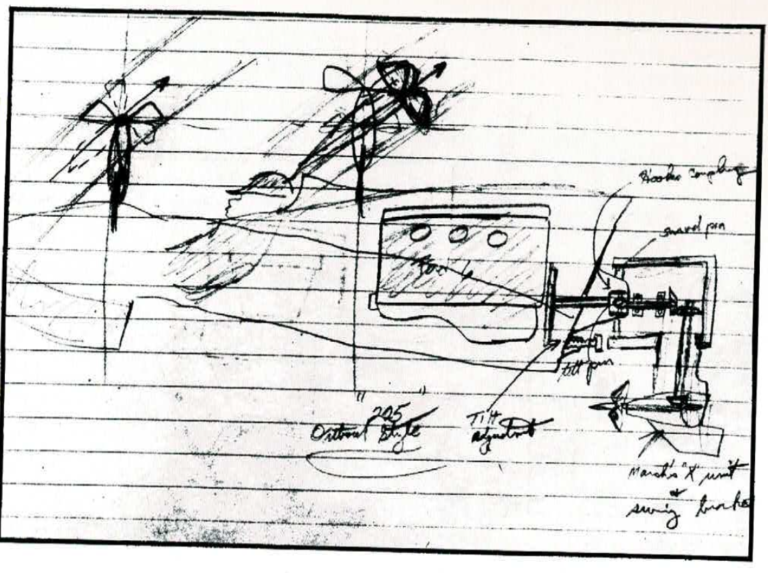
A portion of Strang’s M.I.T. invention ledger for 1948 clearly shows the very first depiction of the modern sterndrive, including tilt-trim adjustment.
He found an aluminum car racing engine in Europe called the "Coventry Climax". He intended to mount it to the lower end of an outboard, leaving all outside components to be still considered an "outboard." When he discovered it wouldn't be legal, he continued to refine the idea of an automotive engine with an outboard lower unit, but this time with the engine inside the boat and the drive unit outside. In his engineering, "invention ledger," he drew various versions of his design and then dated and signed the pages, which was MIT's procedure. One of those entries in 1948 was for the final version of a modern stern drive complete with the "universal joint" linkage, which would ultimately be patented, not by Charlie Strang, but by Jim Wynne. In the explicit drawing, he identified the universal torque transmitter by its scientific name, "Hookes Coupling." He labeled and identified the tilt and swivel pin features within the coupling exactly as they would appear on the patent application submitted ten years later by Jim Wynne.
Strang couldn't decide what to call his new drive; he had been a comic book fan in his younger days and remembered a voluptuous siren named Apacinata (Appassionata) Von Climax. Since he had considered joining his drive to the Coventry Climax engine, he called the stern drive the AVC drive.
In the summer of 1951, after working only two weeks for the Kiekhaefer Corporation, Charlie Strang disclosed his idea to Carl Kiekhaefer. These were great times for Carl. He was in transition between the two-cylinder Lightning models and the more powerful four-cylinder Thunderbolt models.

Carl Kiekhaefer was known for his showmanship. Carl Kiekhaefer
He was having great success with his 25 horsepower model and was setting his sights on OMC and their even larger horsepower outboards. Strang was passionate about the idea, but Carl showed no interest at all. He was not only uninterested but also went on to call the idea ridiculous, referring to Strang as nuts. Then he told Strang it was a "horse _ _ _ _ idea."
Charlie got caught up in all the activities at Kiekhaefer, including road racing. He kept thinking about his AVC drive and his new experiences with powerful engines from Chrysler, Ford, and Chevrolet, which were used in stock cars.
In 1955, aboard Kiekhaefer's Beech 18, Charlie Strang and Jim Wynne were flying to Texas to testify in an outboard motor product liability case. They listened to the Sugar Ray Robinson vs Carl "Bobo" Olson boxing fight on the radio, and afterwards, the conversation drifted to engineering and the potential speeds of outboard motors. On this flight, the greatest conspiracy in the history of the marine industry began.
Charlie sketched up his AVC drive idea, and he got very excited about it. He talked to Charles "Alex" Alexander about it. "Alex" had been promoted to engineering VP and reported directly to executive VP Charlie Strang. Wynne also reported directly to Strang. A series of secret conversations between Strang, Alexander, and Wynne began discussing the AVC drive and its possibilities. They decided to develop the new product themselves, without Carl Kiekhaefer's knowledge.
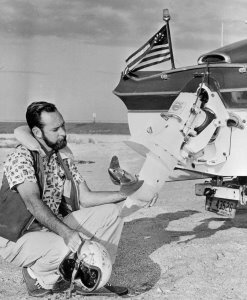
Jim Wynne invented Volvo Penta’s Aquamatic drive. He was named the most influential person in the motorboat industry in the 20th Century, according to a ranking in the highly regarded Motor Boat & Yachting.
Carl and Jim Wynne were close friends at this time (an event involving a woman would end this in 18 months), and he (Jim) was appointed chief engineer of the proving grounds. Charlie was second in command as Executive Vice President, and Alex held the highest engineering position in the company. These three men were actively conspiring to build what would become the most significant product in marine manufacturing behind Carl's back.
In the spring of 1958, Jim Wynne left Kiekhaefer Mercury and, in less than 90 days, "invented" the stern drive. Charlie Strang and Charles Alexander remained at Kiekhaefer Mercury and continued to support his development of a prototype AVC drive. A company, Hydro Mechanical Development, was formed and headed by Wynne.
Unable to raise the enormous funds required to tool and produce the drive, they began looking for help. In early 1958, they met with John Buehler, president of Indiana Gear Works and also the U.S. licensee of the Hamilton Jet Drive of New Zealand. The book recounts the unusual meeting, where Buehler, a large man in a Boy Scout uniform, had a massive office with the rear ends of animals mounted on the walls, each with an arrow sticking in it. Buehler was convinced that Hamilton Jet Drives would take over the industry, so he was not interested.
In Florida, Wynne completed the "cobbled together" prototype in his parents' garage. Remembering the importance of secrecy learned from Kiekhaefer, he covered the garage windows and spoke to no one about it until the prototype was completed and tested. He borrowed a 20-foot fiberglass boat from Woody Woodson (founder of Thunder Boat Company in Miami) and installed the new drive. He covered it up and trailered it to Pelican Harbor on the Intracoastal Waterway in Miami before dawn. After a few trial runs and some adjustments, he was satisfied that the concept would work.
Shortly thereafter, John Jarnmark, the New Jersey-based general sales manager for Volvo Penta, made a routine sales call on Wynne, following up on an 80-horsepower engine that had been delivered without the reverse gear. Wynne told him he was working on a new application for the engine that could produce a lot of sales. Jarnmark was interested, but Wynne could not disclose more until the patent applications were filed. After they were filed, he invited Jarnmark back, and he was very impressed. Jarnmark sent diagrams, photos, and descriptions of the device to Volvo in Sweden.
Wynne was asked by Ole Botved, the manufacturer of Botved-Coronet outboard boats and cruisers in Denmark, to join him as one of three pilots trying to cross the Atlantic in an outboard boat. He flew to Copenhagen for the preparations and then traveled to Sweden to meet with Harald Wiklund, the president of Volvo-Penta from 1949 to 1977.
When Jim walked into his office in 1958, he had already been president for 9 years, and the company had been growing dramatically. Wiklund was very impressed by the idea. Wynne was still thinking that Charlie Strang would soon leave Mercury to join him in the venture. Now that Volvo was seriously interested, he called Strang. Carl had just proposed that Strang head up a public Kiekhaefer Corporation as president. The war with OMC was at a critical stage, and he was swamped, but he knew the potential of the new drive. If he chose to leave Kiekhaefer, Jim would negotiate to buy Volvo engines at a volume discount; if he stayed, Jim would negotiate a license agreement with Volvo for them to produce the drive and market it with their engines. Strang told Wynne, "Jim, do what you want with it."
Wynne met again with Wiklund to proceed to negotiate the licensing agreement. The initial deal was $7 for each unit produced by Volvo over the lifetime of the patent, plus 12.5 percent of any license income Volvo might receive from other builders. Sales initially faltered, and a rate of $3.50 per drive was agreed upon. Later, Wiklund felt the agreement was too much in Wynne's favor, as all he brought was the idea. They had to develop and produce it.
Strang and Wynne agreed that Wynne would receive credit for the invention of the drive to protect Strang's position with Carl Kiekhaefer. They understood that Strang could be held liable for disclosure of the idea while still on Kiekhaefer's payroll. The bond of secrecy between Strang, Wynne, and Alexander would last over 30 years.
After the outboard crossing of the Atlantic, Wynne appeared on the TV program, "I've Got A Secret," and stumped the panel. "Little did they realize, Jim Wynne and Charlie Strang both had an explosive secret that would remain hidden for thirty long years."
As Volvo-Penta began a crash program to produce the AVC drive, which they called the Aquamatic, Wynne found he was unable to answer many of the technical questions being posed by Wiklund and their chief marine engineer, Neil Hanson. Wynne had to disclose that he was not the original inventor, that Charlie Strang was, and swore them all to secrecy. During the late summer of 1958, a series of clandestine meetings between them were arranged.
Often, they were in motels near boat races. Strang was very concerned about Kiekhaefer's spies and his volatile nature. Wiklund said he felt he spent more time that summer in an airplane than behind his desk in Gothenburg, Sweden. With Strang's guidance, the drawings were finalized, and Swedish engineers rushed to complete tooling in the fall and early winter of 1958.
The Aquamatic was unveiled with great fanfare at the 1959 New York Motor Boat Show in January. It had taken the Volvo engineers less than 6 months to produce the tooling for the prototype unit. Jim Wynne was a guest in the booth to help answer questions about "his new invention." Ingemar Johansson, the Swedish heavyweight boxing champion, made an appearance to pose with Wynne.
Carl Kiekhaefer was stunned to see the vast crowds in the Volvo booth and was miffed at dealers asking him about the merits of the new drive. Almost a year later, Carl acquired an Aquamatic and installed it on an 18-foot Dunphy boat, testing it himself at Lake X.
His report, sent to Charlie Strang before the end of January 1960, was perhaps the most biased, unfair, and clouded evaluation that an engineer could ever have made. " He was steaming over the drive because he considered the concept without merit and because Jim Wynne was involved. He never recalled discussing the AVC drive with Charlie Strang years earlier. Carl's comments on the test report were contrary to just about everybody else's opinion of the new unit.
"Volvo engine: Extremely noisy, even though compartmented with sound-absorbing material as a liner. Noise is a combination of intake and mechanical. Gear whine is noticeable at part throttle, although it is not present at high speeds.
Steering is extremely dangerous. Spun out of the boat at the first hard left turn. Except for center position, steering force so violent as to twist wheel out of hand. ...
"Installation costs must run considerably higher than an outboard since one large hole must be cut into the transom to take the engine mount. .. A water pickup, in addition, must be installed on the underside of the boat. ...
"The Volvo outboard-inboard drive, aside from its cost and weight disadvantages, has all the other disadvantages of an inboard installation and while a particular segment of the public might go for it, I do not believe it is a threat to outboard motors at this time. .. Gone too is the stimulant of annual model changes. Styling plays no part. The product does not advertise itself, being hidden, and has all the romance of a 371 diesel power plant!
"I believe a destruction test at wide-open throttle at normal engine rpm is in order."
This test report was only part of a nearly 2-year-long tirade by Carl. He was irritated by Volvo's advertising entering into his two territories of speed and endurance. Wynne had learned of the importance of racing and endurance marks while at Kiekhaefer. He obtained one of the 10 prototypes and secretly prepared another Woody Woodson 18-foot Thunderbird Boat for the Miami-Nassau race. He was afraid Volvo would not let him run one of their precious "boat show" prototypes in a race. He took on board Bill McKeown, editor of Popular Boating magazine, as co-pilot. That magazine, now called Boating, was very popular at the time. Later, Harald Wiklund, Volvo president, told him that if he had any idea he was going to race it, he would have personally come over and taken it away from him. They won their class in the race and finished 4th overall, receiving a landslide of favorable publicity for the Aquamatic drive.
As Volvo sales began to eat away some of Carl's 70 HP outboard sales and dealers and distributors kept asking when Mercury would come out with a sterndrive, Carl asked Charlie Strang to begin thinking about the concept of a Mercury sterndrive (we can only imagine how this made Strang feel, as he was the secret original inventor of the drive).
In June 1960, Carl tried to negotiate an agreement with Volvo to be their exclusive sales agents for the Aquamatic in the U.S. Carl wanted Volvo to actively enforce its patent to keep others (OMC) out of the stern drive business (out of competition for his OB sales. The deal unraveled when Volvo wanted a guaranteed minimum of 10,000 units a year. If Carl had been successful in his reasoning he would have prevented the expense of tooling up for another drive and protected large HP OB sales.
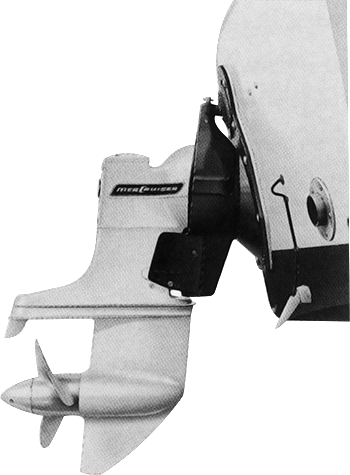
Sales of the Aquamatic initially struggled. The initial run of 10,000 units only sold 3,000 by the end of 1959. The drive was being highly touted in the press, and people liked it, but it wasn't moving. It was easy for boat builders to sell boats without engines, and consumers would buy an outboard motor and install it in the boat. Wiklund turned to Ole Botved, who had crossed the Atlantic with Wynne in the outboard boat. He agreed to make Aquamatics available interest-free for a whole year if he would install them in his line of Coronet boats. It was a great success.
In the fall of 1960, in a Mercury sales meeting, Carl admitted the possibility of a Mercury sterndrive, but characterized the concept as a pure loser. In a speech to distributors on January 13, 1961, he finally broke down and told the public that if they wanted it, he would build it. Charlie Strang continued to develop the project, and Carl didn't notice how easy it was for him (the original inventor). Carl was concerned that Volvo would force them to pay for the patent, but Strang knew they would not, due to the secrecy surrounding the original inventor.
Kiekhaefer learned that OMC was also working on a sterndrive and would be announcing it at the Chicago Boat Show on March 25, 1961. He moved up Mercury's announcement two days to March 23, followed by a large display in Mercury's booth on the opening day of the show, March 24. A week before the press announcement, the name MerCruiser was selected for the stern drive.
OMC's V-4, two-cycle 80 HP stern drive, the OMC-480, was surpassed by MerCruiser's four-cycle automotive engines with 125 to 200 HP.

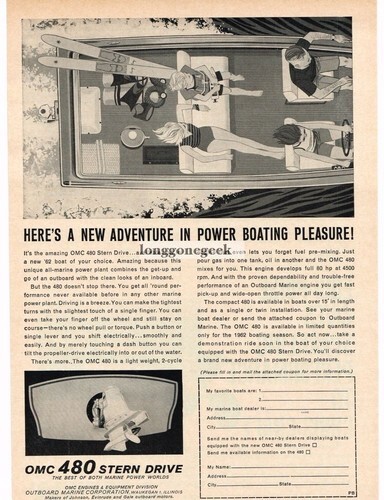
Carl took the conservative approach and only sold the drive to engine manufacturers, who sold the engine and drive package to the boat builders. Mercury dealers couldn't care less about the drive because they could not market it themselves. Strang remembered when he first got Carl to take the drive seriously. He told him that he and his mother had seen a little 4-cylinder Chevrolet in a local dealership. He took Carl in the next day and told him they needed to put that engine with the stern drive. Carl told him to contact GM. That afternoon, they flew to Detroit and brought back the first engine. Carl was still dragging his feet on the idea, and Strang told him that if he didn't like it, he should price it, and he would buy him out on this project. "Never heard another complaint from him," Strang said.
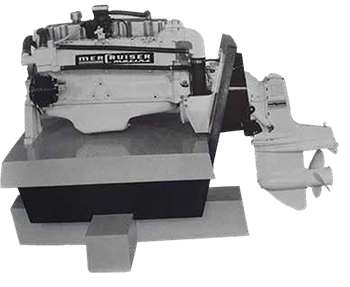
Carl wasn't aware that Strang and Charlie Alexander had already tried to raise money to fund the project with Jim Wynne. Carl was about to take care of the strategic errors made by Volvo and OMC of marrying the drive to low horsepower engines. GM's 110- to 140-hp engines significantly increased the market appeal of the drive.
As horsepower increased, Kiekhaefer had Strang design two more drives, the MerCruiser I and the MerCruiser II, to accommodate 225 HP and even 310 HP engines. By late 1961, Mercury had captured the bulk of the market by offering two models and a wide range of engines. Mercury began to receive orders from nearly every boat builder in the country.
By 1962, only 3 years after the introduction of the Aquamatic, 16 manufacturers were producing stern drives. When Mercury opened up to direct sales to boat builders, they eventually captured 80% of the world market. The conspiracy between Wynne and Strang actually worked to Carl's advantage. This secret relationship allowed someone else to go first and test the market, while eventually making Mercury's entry possible.
Wynne's patents wouldn't issue for ten years because another inventor, C.E. Mac Donald of Seattle, had constructed a prototype before Wynne's in Miami. MacDonald filed his application just two weeks after Wynne. They claim to be unaware of each other's activities and independent discoveries of the same idea. Wynne was awarded the patent (3,376,842) on April 9, 1968. Wynne was rewarded with substantial amounts of cash from the Volvo agreement that was in effect until the patent expired in 1985. Charlie Strang would never accept a penny for his invention and went on to become the board and chief executive officer of OMC during Carl Kiekhaefer's lifetime, but never disclosed the story of the invention of the stern drive while Kiekhaefer was still alive.
1963 - Type 1-Sterndrive
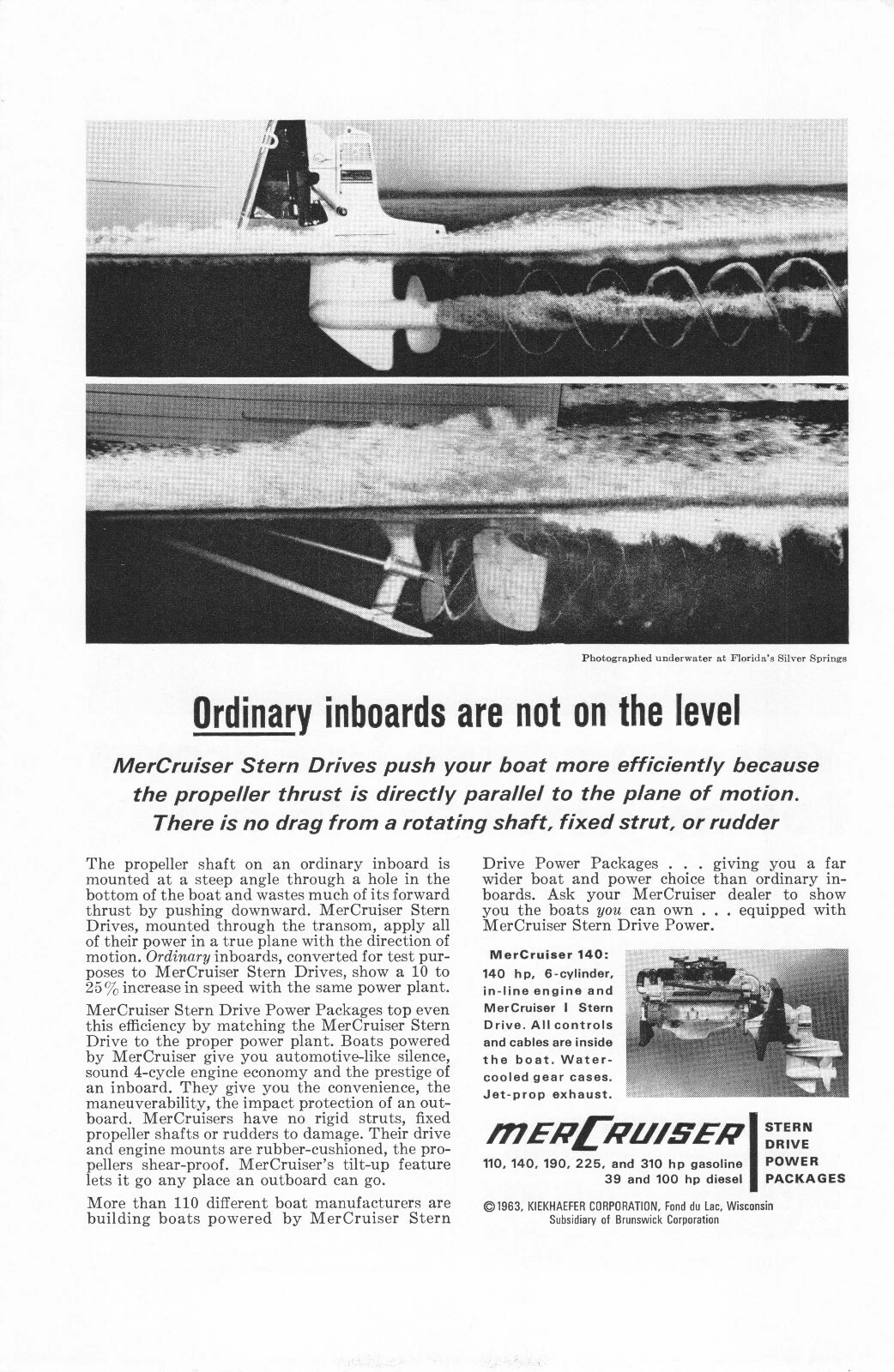
- One single drive ratio only.
- White colored drive unit.
- The lower unit uses an outboard-style shift cam and cam follower (plunger) mechanism.
- Manual tilt with outboard-style manual reverse lock assembly.
- Manually adjusted the trim in the position pin.
- Separate upper and lower housings. (Separate vent and drain plugs)
1964 - 1A Drive, 1B Drive, & 1C Sterndrive
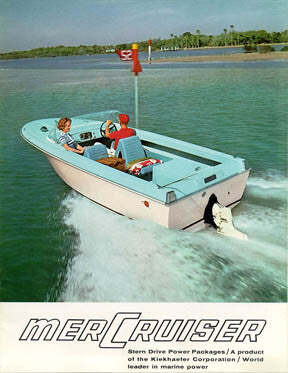
- Three drive ratios
- Early production drive units were white colored, Later production was black colored
- The lower unit uses an outboard-style shift cam and cam follower (plunger) mechanism
- Manual tilt with outboard-style manual reverse lock assembly
- Power Tilt was optional on 110 / 120 / 140 / 150 / 190 / 310 models
- Manually adjusted the trim in the position pin
- Separate upper and lower housings (separate vent and drain plugs)
- Late production units had a hydraulic tilt system (low-pressure pump)
1965-1968 - Renault 60, 1A, 1B, & 1C EZ Drive
1965-1968 - 1A EZ Drive, 1B EZ Drive, 1C EZ Drive, & 0" 60 Drive
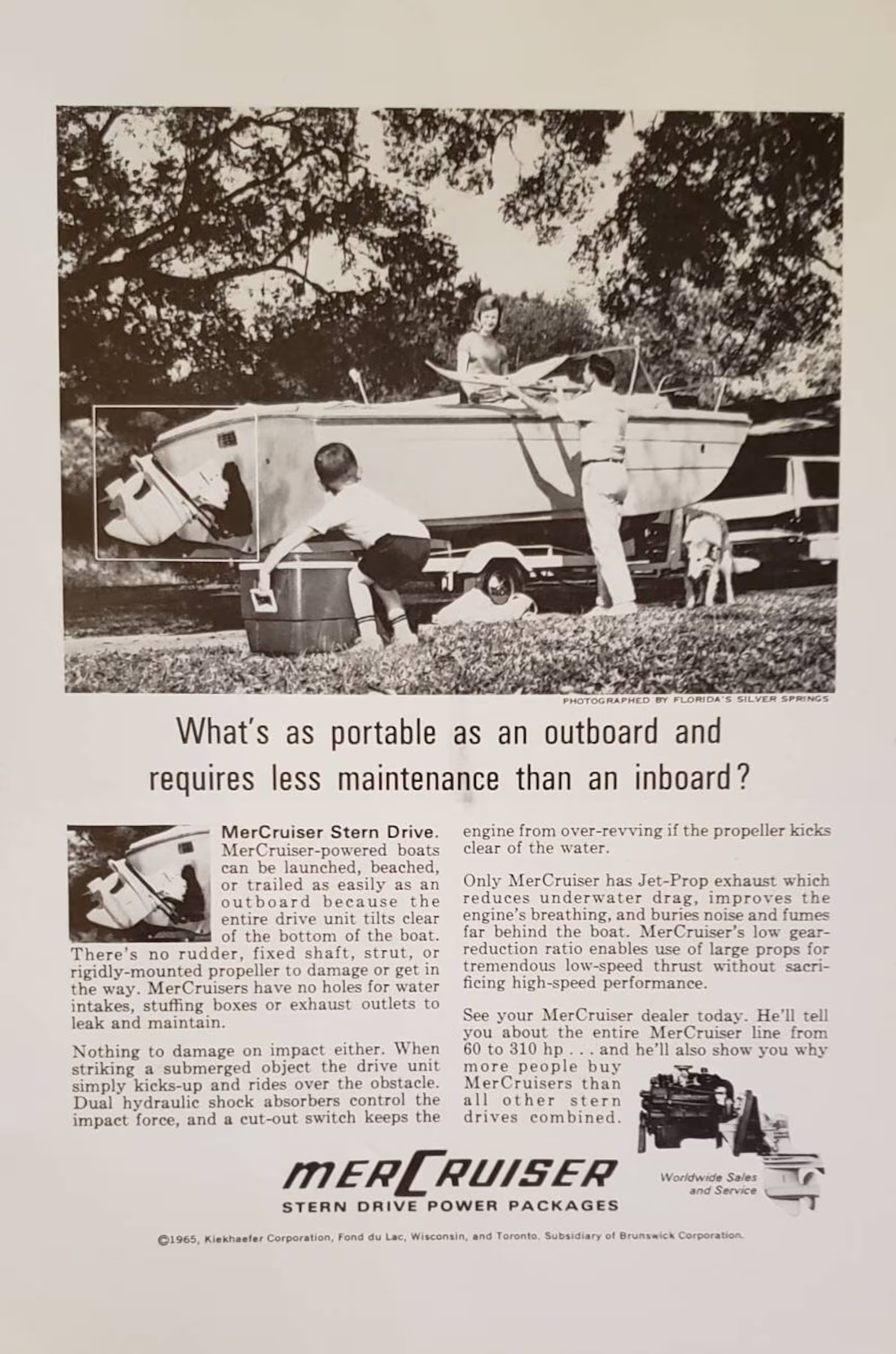
- Three drive ratios
- Black or White colored drive unit
- Lower unit uses current style shift crank and spool shift mechanism (E-Z Shift)
- Manual tilt with outboard-style manual reverse lock assembly
- Power Tilt is optional on all models
- Four-position manual adjustment tilt position pin
- Separate upper and lower housings (separate vent and drain plugs)
- 1965 - 1966 - Hydraulic tilt system (high-pressure pump) available
- 1967 - Introduction of the hydraulic Power Trim system (trim and tilt)
- 1968 - Oil passage installed between upper and lower housings- Quad Ring used to seal passage-one vent and one fill plug for the complete drive unit
0" 60 Drive
- 0" 60 Drive was a smaller version of the drive unit (lower unit was approximately the size of a 50 HP outboard lower unit)
- Mechanical shift with hydraulic actuation
The water pump was located under the top cover of the drive unit.
1967-1982 - MC-1 Drive
0" 80 Drive (1967-1969, Renault 80)
0* 90 Drive (1970-1972, Renault 90)

MC-1 Drive
- Different drive ratios for each package
- MC-1 Drive similar to the 1 (A-B-C) EZ Drive
- Drives now referred to as the "MerCruiser 120", 140, etc., are named after the engine HP used in the packages
- Power Tilt is optional on all models
- Power Trim was optional on the MerCruiser 120 and 160 models
- Earlier models had a tilt stop switch located at the top of the gimbal ring
- Later models have a side-mounted rotary trim sender and tilt (cutout) switch
- Shift plate mounted on transom with reverse lockout valve
0" 80 and 90 Drive
- 0" 80 and 90 were similar to the 0" 60 model drive.
- Different ratios for larger engines.
1983-1984 - MC-I Drive Unit & 1-R Drive
- Upgrade of the drive unit's exterior design:
- Redesigned top cover (lifting eye removed)
- Bell housing (with straightened sides and removed ears), lower unit hydrodynamic shape reconfigured, and skeg swept back.
1985 - 1-MR Drive
- New reverse spiral cut gear housing gears.
- Gears are used to draw together under load. Now they are forced apart under load. This change was made for greater durability.
- The drive shaft bearing (below the water pump) was changed, and a threaded retainer was added to hold the drive shaft bearing cup in position.
- Near-net forged gears
- Letter "A" stamped on the end of the propshaft to differentiate the new MR Drive from the R Drive.
1986-1991 - Alpha-One Drive
- Similar to I-MR Drive. Name changed.
Seals that used to ride on the upper driven gear in the Alpha One driveshaft housing are now located at the bottom end of the Gen II driveshaft housing. They now seal on the driveshaft itself, allowing the gear lube to lubricate the splines at the top of the driveshaft. - There is a new anodic plate located on the front edge of the drive shaft housing splash plate.
Lateral wear pads are located on the driveshaft housing where the gimbal ring pads come in contact with the driveshaft housing. - A filler wall is positioned just to the rear of the water pump housing, serving as a dam to hold water around the pump housing and prevent the pump from drawing air into the cooling system.
Alpha One Gen II Gear Housing Changes

- The shift shaft bushing is redesigned. It is secured to the gear housing with two bolts and washers. The bushing serves a dual purpose, supporting and sealing the shift shaft while also providing a connection for the speedometer fitting. There is a small sleeve around the shift shaft that helps to protect the oil seal in the bushing. It is positioned so that it lightly touches the top of the oil seal.
- A new water pump assembly is installed. The housing is stainless steel. A larger, veined impeller is used.
This is a low-pressure, high-volume system, as opposed to the older high-pressure, low-volume system used
on the Alpha One models. - The driveshaft no longer has an O-ring groove near the top end of the shaft. It was removed when the lower oil seals of the driveshaft housing were installed. Oil in the driveshaft housing now lubricates the splined area of the drive shaft.
- There is a second filler wall positioned just below the primary filler wall, located in the driveshaft housing (to the rear of the water pump housing). This wall assembly functions as a dam, holding water around the pump housing to prevent the pump from drawing air into the cooling system.
- Water pickups in the gear housing strut area are now cast in, replacing the inserts that were used in earlier version models.
- Skeg trailing edge now has a knife edge.
Alpha One Gen II Driveshaft Housing Changes
- The driveshaft housing U-joint pinion assembly is similar to the Bravo Drive version. Preload is adjusted in the
same manner. The pinion gear is still located by shimming, as in the Alpha One unit. - There was a dipstick in the top cover, like the one used on early Bravo units. If the Gear Lube Monitor kit was installed, the dipstick was replaced with a plug.
- The driveshaft housing to gear housing mounting fasteners have been changed from studs to bolts and flange nuts. A bolt has also replaced the front stud.
- The early models had a twist-and-snap speedometer connection. Now, a push-button, quick-disconnect fitting is used.
- A water tube seal replaces the water pocket cover assembly that was used in Alpha One models. The new water tube is slipped into this seal.
Posted by Norm Peterson


